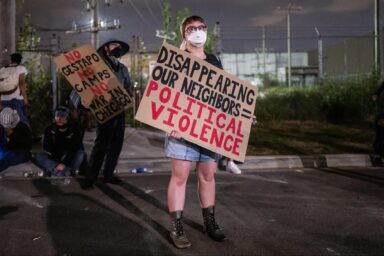Do ICE agents who penned a letter requesting a separation from the agency want to distance themselves from Trump's policies, or is this claim a case of media overreach?
A letter sent to Homeland Security Secretary Kirstjen Nielsen back in June should have been an internal document having to do with workplace structuring. Instead, it was hailed by Abolish ICE activists as proof that even those working within one of the Trump administration’s most controversial agencies were ready to upend the system.
The letter in question, penned and sent by 19 supervisory agents from ICE’s Homeland Security Investigations (HSI) division had a simple plea: to detach from the umbrella agency and form their own department. (The letter did not include the names of the agents, and efforts to reach them were not successful.)
What resulted was a narrative widely disseminated by media outlets that suggested the Abolish ICE movement had sympathizers within the ranks of DHS.
The letter seemed to make the case that even those tasked with carrying out the Trump administration’s loosely defined executive orders — which have enabled detainment centers and deportation tactics that organizations like the ACLU have categorized as inhumane — are intent on the dissolution of the agency they serve.
But at least one former ICE official thinks otherwise, and offers a different interpretation of what the agents’ goals were. His view raises the possibility that the actual story behind the letter might hinge less on idealism and more on department in-fighting — and may more realistically conform to the image of how ICE actually views the people they are mandated to target.
In the letter’s opening paragraphs, the agents listed a number of reasons for the proposed schism. Among them, as the letter detailed, were to “secure the United States against nefarious actions perpetrated by terrorists and transnational criminal organizations” and to circumvent limitations set by “finite operational budgets and resources.”
The agents cited differing “strategic locations” than other departments under the ICE umbrella; that their narcotics and trafficking operations are tied to the border, as opposed to the additional work in the interior that agencies such as Enforcement and Removal Operations (ERO) focus on. They pointed out dissimilarities in basic management, down to staffing templates and shift work.
But the part of the letter that ended up capturing public attention was what the agents termed as an effort to curb an “investigative independence … unnecessarily impacted by the political nature” of the public opposition to the policies of detainment and deportation that have already become a hallmark of President Donald Trump’s legacy.
The memo, which went viral after it was obtained and released by the Texas Observer, provided the latest fodder for supporters of the Abolish ICE movement. Most media outlets that reported on the story touted it as a form of dissent from the inner workings of the DHS, a show of protestation from the belly of the beast.
People who dismiss “Abolish ICE” should explain what they intend to do about a lawless agency with a seemingly intractable culture of cruelty. https://t.co/99j3lr0D8h
— b-boy bouiebaisse (@jbouie) December 13, 2018
The angle clicked with readers. “Seeking a split from ICE, some agents say Trump’s immigration crackdown hurts investigations and morale,” read one headline from the Washington Post. The original Texas Observer article proclaimed “ICE Criminal Investigators Ask to Be Distanced from Detentions, Deportations.” When the letter made the rounds again in late November, after political commentator and comedian Hasan Minhaj featured it on his Netflix series Patriot Act, Minhaj proclaimed that even ICE, one of the de facto “most hated government agencies … doesn’t want anything to do with ICE.”
With that, a narrative was fully formed. Now, the memo begged this question: like the rogue government Twitter accounts purportedly run by White House staffers that popped up shortly after Trump assumed the presidency, are there still members of an abstract resistance working from within?
But if you ask former ICE-HSI supervisory special agent Jerry Robinette, the idea that the letter demonstrates opposition from within the agency to the current administration’s immigration and detention policies is just wishful thinking.
Or, as he put succinctly in an interview with WhoWhatWhy: “Morally opposed? Bullshit.”
Robinette, who served as a special agent in charge of ICE-HSI operations in San Antonio, Texas, from 2008 until 2013, opined that the letter was purely an issue of funding rather than a gesture of solidarity with pro-immigration activists. While followers of Abolish ICE might like to think otherwise, the frantic rush to claim budget money is an “effort that has been going on for a long time.” (An email sent from WhoWhatWhy to DHS’s Office of Public Affairs to corroborate this went unanswered.)
“The driving force in trying to separate the two [and institute] totally separate funding mechanism[s] is that every year towards the end of the year, the ERO side of the house wants [more] money, and the money comes out of the investigative pocket,” explained Robinette. “The money that you thought was going to be there for investigations — to conduce investigative travel, to buy equipment — is gone.”
The melee over budgetary allotments between the agencies stems from the differences in the respective goals of HSI and ERO. As its full name suggests, ERO oversees the forced removal of undocumented immigrants, the vast majority of whom are non-criminals. In short, they’re the ones responsible for monitoring the deportment and detainment processes, and subsequently the ones that get the most airtime in the news cycle.
HSI, on the other hand, deals solely with threats to national security and other criminal enterprises, such as human trafficking, human rights violations, and money laundering.
The practice of dipping into investigative reserves, which can result in a loss of HSI’s discretionary funding, is merely a symptom of DHS’s organizational issues as a whole. It began when Customs was removed from under the jurisdiction of the Department of Treasury and put under the watchful eye of DHS — which itself was formed in response to the September 11 attacks — in tandem with the disbanding of INS.
At the time, Robinette — who transitioned from law enforcement to his first post in Customs in 1991, and had been appointed as a deputy director for a terrorist financing unit task force in Washington, DC — was there to witness the departmental transitions and the chaos that ensued. “Everything was code red,” he recalled, “[and then] a couple years later in 2003 there’s this big reorganization we’re all hearing about.”
“They bring the immigration investigators and the US Customs special investigators together and form ICE. Then, of course, they take the inspectors, the people that used to be a part of INS, the uniformed people that used to be part of Customs and the border patrol, and they all form Customs Border Protection. You kind of have your brothers and sisters you grew up with in Customs now kind of separated.”
In addition to working side by side with investigations officers trained to operate differently and who investigated different crimes, there was a fracas over “who got what, who inherited what funding, who inherited what pockets of funding, who inherited what bills,” prompting spats between departments which still permeate the way these agencies function.
It doesn’t help that ERO, as the face of ICE, has caused local law enforcement and governing bodies to distance themselves from working with any and all agents, including HSI. “Even the [LAPD] cops don’t like us anymore,” one agent complained in a piece published by the Los Angeles Times — a police force which has been historically lax when it comes to internal corruption.
Rather than blaming the rift between law enforcement and field agents on policies and alleged human rights abuses, Robinette instead put the onus on sanctuary cities and the politicians who maintain them — many of whom he classified as “knucklehead[s]” whose criticisms are populist and “irresponsible.”
But even if the letter had more to do with departmental funding than originally reported, does that automatically mean it had nothing to do with taking a moral stance against ICE-ERO’s day-to-day operations? Or was it leaked intentionally, with the idea that the current political climate (and resulting assumptions made by an ICE-hating contingent of the public) would help bolster their bid to separate? According to Robinette, yes.
“I don’t know if the letter was leaked, [but] I believe those people that signed it, all they were trying to do is bring an issue to the table, an issue that was very important to them, in hope that they would get attention and consideration and relief,” he speculated. “The [point of the] attention was to try and come up with a solution. Every year, losing a significant piece of your money is devastating.”


